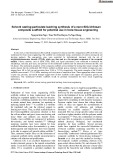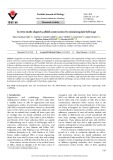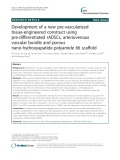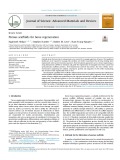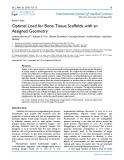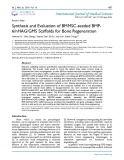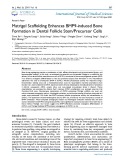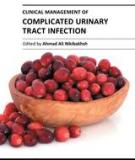
Scaffolds for bone tissue engineering
-
This work aimed to introduce nanosized SiO2 into the CS matrix to produce three-dimensional (3D) scaffolds by solvent casting combined with salt leaching using NaCl as a porogen agent. The amount of the porogen to polymer was varied to produce 3D CS/SiO2 scaffolds with suitable pore sizes and porosity.
 7p
7p  dianmotminh02
dianmotminh02
 03-05-2024
03-05-2024
 2
2
 1
1
 Download
Download
-
A novel polycaprolactonee zeolite nanocomposite Y (PCL - Zeol) scaffold was fabricated as a carrier for sustained release of cisplatin (Cis) for bone cancer treatment. In this regard, after synthesis of Zeol with a proper morphological uniformity, Cis was loaded with a high loading capacity into the cavities of Zeol nanoparticles.
 11p
11p  viberbers
viberbers
 09-08-2023
09-08-2023
 4
4
 2
2
 Download
Download
-
In this article, chitosan/biphasic calcium phosphate (CS/BCP) nanofibers were prepared by electrospinning. From the culture of osteogenic cells, the biocompatibility of CS/BCP nanofibrous substrates was identified and increased by the photocrosslinking.
 7p
7p  visherylsandber
visherylsandber
 04-07-2022
04-07-2022
 9
9
 2
2
 Download
Download
-
In this study, a fibrous bone tissue engineering scaffold was produced using poly(lactic-co-glycolic acid) (PLGA). Different concentrations (20%, 25%, and 30%) of PLGA (PLA:PGA 75:25) (Mw = 66,000–107,000) were wet spun using coagulation baths composed of different ratios (75:25, 60:40, 50:50) of isopropanol and distilled water. Scanning electron microscopy (SEM) and in vitro degradation studies were performed to characterize the fibrous PLGA scaffolds.
 11p
11p  thiencuuchu
thiencuuchu
 27-11-2021
27-11-2021
 5
5
 1
1
 Download
Download
-
In this study, a hydroxyapatite (HA) based scaffold was used together with human adipose stem cells (hASCs), human bone marrow stem cells (hBMSCs) and gingival epithelial cells to mimic human tooth dentin-pulp-enamel tissue complexes and model an immature tooth at the late bell stage in vitro. Characteristics of the scaffold were determined via SEM, FTIR, pore size and density measurements. Changes in gene expression, protein secretions and tissue histology resulting from cross-interactions of different dental tissues grown in the system were shown.
 13p
13p  thiencuuchu
thiencuuchu
 27-11-2021
27-11-2021
 10
10
 1
1
 Download
Download
-
Tissue engineering approaches for reconstruction of large bone defects are still technically immature, especially in regard to sufficient blood supply. Therefore, the aim of the present study was to investigate the influence of osteogenic stimulation and treatment with VEGF on new bone formation and neovascularization in hMSC-loaded cancellous bone scaffolds in vivo.
 10p
10p  viannito2711
viannito2711
 20-04-2021
20-04-2021
 6
6
 1
1
 Download
Download
-
Development of a pre-vascularized tissue-engineered construct with intrinsic vascular system for cell growth and tissue formation still faces many difficulties due to the complexity of the vascular network of natural bone tissue.
 14p
14p  vianrose2711
vianrose2711
 26-04-2021
26-04-2021
 15
15
 2
2
 Download
Download
-
The osteogenic capability of the scaffold is influenced by the interconnections between the scaffold pores which facilitate cell distribution, integration with the host tissue and capillary ingrowth. Hence, the preparation of bone scaffolds with applicable pore size and interconnectivity is a significant issue in bone tissue engineering
 9p
9p  tamynhan4
tamynhan4
 06-09-2020
06-09-2020
 13
13
 2
2
 Download
Download
-
The surgeon has the availability of a wide number of scaffold micro-architectures thus needing adequate guidelines for the choice of the best one to be implanted in a patient-specific anatomic region.
 7p
7p  vihasaki2711
vihasaki2711
 12-11-2019
12-11-2019
 10
10
 1
1
 Download
Download
-
Bioactive scaffolding materials and efficient osteoinductive factors are key factors for bone tissue engineering. The present study aimed to mimic the natural bone repair process using an osteoinductive bone morphogenetic protein (BMP)-6-loaded nano-hydroxyapatite (nHA)/gelatin (Gel)/gelatin microsphere (GMS) scaffold pre-seeded with bone marrow mesenchymal stem cells (BMMSCs).
 11p
11p  vinasaki2711
vinasaki2711
 12-11-2019
12-11-2019
 20
20
 1
1
 Download
Download
-
Tissue engineering is a rapidly-growing approach to replace and repair damaged and defective tissues in the human body. Every year, a large number of people require bone replacements for skeletal defects caused by accident or disease that cannot heal on their own. In the last decades, tissue engineering of bone has attracted much attention from biomedical scientists in academic and commercial laboratories. A vast range of biocompatible advanced materials has been used to form scaffolds upon which new bone can form.
 17p
17p  caygaocaolon1
caygaocaolon1
 13-11-2019
13-11-2019
 11
11
 2
2
 Download
Download
-
Bone tissue engineering requires a combination of cells, efficient biochemical and physicochemical factors, and biocompatible scaffolds. In this study, we evaluated the potential use of injectable Matrigel as a scaffold for the delivery of rat dental follicle stem/precursor cells (rDFSCs) transduced by bone morphogenetic protein (BMP) 9 to enhance osteogenic differentiation in vitro and promote ectopic bone formation in vivo.
 9p
9p  vinasaki2711
vinasaki2711
 12-11-2019
12-11-2019
 12
12
 1
1
 Download
Download
-
Now the resist height upon developing must be calibrated to UV exposure energy, from which the optical density of the device features in the mask may be determined. To this end, the resist height that results from an optimized lithography process was calibrated with a range of optical densities from a reference mask. From this information, the device height profile is encoded into the optical density profile necessary to produce it.
 20p
20p  quynho77
quynho77
 13-11-2012
13-11-2012
 37
37
 1
1
 Download
Download
-
Vitrification has been investigated for tissue-engineered bone and blood vessels. Liu & McGrath (2003) explored the potential of vitrification for the cryopreservation of tissueengineered bone constructs consisting of a hydroxyapatite scaffold-cell complex. Cell survival was 92.0% for suspended cells and 43.0% for attached cells. In terms of tissueengineered blood vessel constructs, the effects of vitrification and conventional cryopreservation were compared (Elder et al., 2005). Collagen-based vascular constructs were used as models in this study.
 304p
304p  kmkmkmkmkm
kmkmkmkmkm
 08-09-2012
08-09-2012
 53
53
 5
5
 Download
Download
CHỦ ĐỀ BẠN MUỐN TÌM








